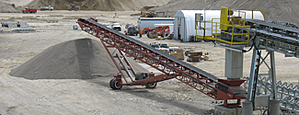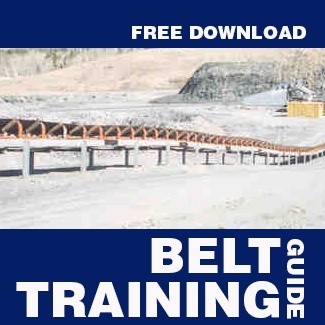 At a recent training seminar at the ELRUS branch in Leduc, AB, participants were asked to list their single biggest challenge or problem in regard to their conveyors.
At a recent training seminar at the ELRUS branch in Leduc, AB, participants were asked to list their single biggest challenge or problem in regard to their conveyors.
The questions were then reviewed and answered before the group which consisted of crushing and screening professionals from across Western Canada and the United States.
The questions raised were:
- What is the best way to track the belt? (Download our Field Guide to Belt Training) We talked about proper belt training meaning attempting to do it with the return idlers and not the take-ups. I then went through the proper belt splicing technique, which was very well received. When asked (to be honest) how many of them track the belt with the take-ups, almost all hands went in the air. Hopefully they will apply what we shared and have much better success in this area.
- How do I keep material from getting into the s-drive pulleys?
Make sure there is a v-plow ahead of the s-drive and check the UHMW to ensure it is still intact and has wear life left. - What is the proper way to change tires on the wrap drive, and is there a way to keep them from breaking the bead seal?
I suggested that he deflate them, install the new tire and re-inflate them once in place. Only put about 12 pounds of air in max. If they continue to break the beads, put tubes in them. - How can I adjust the flashing on the slide pacs with the flip up extensions?
Use a long extension and swivel socket, but we also mentioned that I will talk to our engineers and see if they can make this more accessible. - Is there a better way to secure the base plate to the ground on my TS150 TeleStacker®?
We mentioned that welding angle irons on the bottom of the base plate and bumping it into place with a skid steer may help. - Why does the head shaft on the main of the TS have to be stepped down twice?
We want the thickness in the pulley to prevent shaft deflection, and we have to step down the end of the shaft for the output of the gear reducer, but we will consult our engineers on why the two stages of journaling are necessary. - How do I avoid belt slippage in cold weather situations?
Make sure belt tension is proper and we went over the rule of thumb for that, install a snub pulley at the head end, make sure head pulley lagging is not scuffed smooth and worn out, if so possibly rough the lagging up with a grinder. In extreme cases, a ceramic head pulley may be necessary. - How do I keep material from getting into the echain?
If material is larger than a true finished product (3” minus) they may want to install rock boards, ensure that the hopper skirting is in contact with belt, may need to look at sealing system in load hopper. Frequent inspection and cleaning of the echain, is a requirement. We also talked about the improvements that were made with the Cable Carrier System that has been standard for about two years now. - How can I avoid rocks ripping the belt?
One solution may be to look at installing a Chevron wing pulley. Check flashing at feed point to prevent fugitive material from getting on return strand of the belt. - How do I do bearing changes in confined area? Why tail pulley bushings come loose and move on the shaft?
Make sure they are properly torqued, and if they continue to slip you may want to install a key way in the shaft. - How can I get consistency out of my belt scale readings?
Make sure it is calibrated, make sure to make adjustments when material characteristics change, and make sure it is installed on a conveyor that is stationary for best results. - How do I avoid material slipping on the belt on cold weather, I am currently using a propane torch to de-ice the belt.
You may want to look at an infrared type heater that has a motion detector with kick off when belt stops.
Well there you have it. Of course if you ever have any questions about this or anything to do with crushing, screening and conveying just give our team a call. We're more than happy to help you figure it all out.


